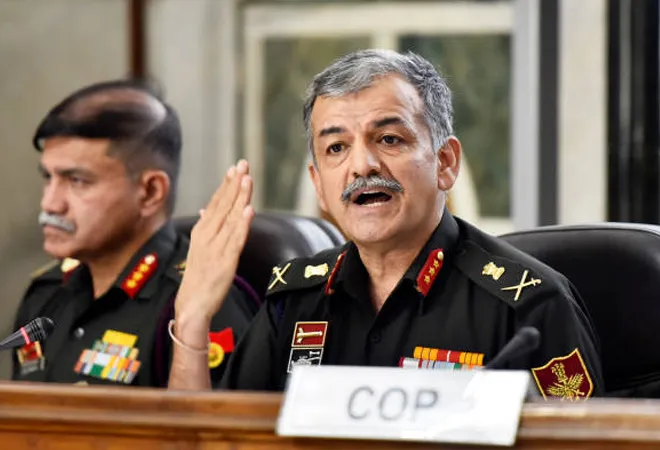 This piece is part of the essay series, The Agneepath Scheme: Radical or Irrational?
This piece is part of the essay series, The Agneepath Scheme: Radical or Irrational?
In what could be touted as the biggest defence manpower reform in India’s independent history, the Union Cabinet on 14 June approved a new recruitment scheme—the Agnipath Scheme—for the armed forces. Coming into immediate effect, the scheme will henceforth guide all the recruitments of soldiers, sailors, and airmen between the ages of 17.5 and 21 to serve for four years. Youths joining the armed forces under the new scheme will be known as Agniveers and their enrolment would be based on an “All India, All Class” basis. The new scheme is a radical departure from the previous recruitment policy under which recruits were required to serve at least 17 years before they could retire with a pension. The scheme is visualised to “bring about a transformational shift towards a more tech-savvy armed forces” by attracting young talent familiar with contemporary technological trends and improving the age profile of the armed forces.
The Agnipath and its rationale
The Agnipath scheme, under which 46,000 Agniveers would be recruited this year alone, applies to the non-officer cadre of the armed forces. To attract the talented youths, the scheme provides several attractive financial packages besides a permanent tenure—the latter being reserved for a maximum of 25 percent of every yearly batch of Agniveers. The financial packages include a gross salary of INR30,000 per month in the first year, increasing to INR40,000 in the fourth year. The Agniveers would also be provided with a non-taxable Seva Nidhi severance package of approximately INR1.171 million, comprising a part contribution from the monthly salary of Agniveers and a matching contribution from the Central government. This is in addition to several allowances and death and disability compensations which would be available to the Agniveers.
The new scheme is a radical departure from the previous recruitment policy under which recruits were required to serve at least 17 years before they could retire with a pension.
The scheme is announced with two primary objectives in mind. One, with a much shorter engagement period of four years, the new recruitment policy is designed to reduce the average age of the armed forces from the present 32 years to 24–26 years. This is in line with the recommendations of the several high-level committees which had advocated for a much youthful cadre to deal with India’s various security threats. With active border disputes with two hostile neighbours that have led to hand-to-hand combat in recent years, the need for a young force, particularly for the Indian army, could hardly be emphasised.
Two, though not officially stated, the Agnipath scheme is driven by the financial exigencies arising largely due to the hefty rise of the manpower cost. Because of the progressive increase of ‘colour service’ (or minimum engagement period) from seven years to 17 years in the 1960s and 1970s and the implementation of recommendations of the successive Central Pay Commissions (CPCs) and the One Rank One Pension (OROP), the manpower cost of the Ministry of Defence (MoD) has grown significantly over the years. The magnitude of the growth could be judged by the fact that in the last 10 years (from 2011-12 and 2021-22), the share of Pay and Allowances (P&A) and defence pension in the MoD’s overall expenditure has increased from less than 50 percent to over 60 percent. This has adversely impacted the procurement and equipment maintenance budgets whose combined share has declined from 36 percent to 25 percent, leading to a piquant situation where the government has found it difficult to pay even for the ongoing contracts.
The Agnipath scheme would go a long way in addressing the ballooning manpower cost of the MoD. The short tenure of the Agniveers would ensure that the maximum outgo on salary for at least 75 percent of Agniveers is capped at INR40,000—a sum which is much lower in comparison to those of the senior soldiers. The bulk of the financial savings would, however, accrue on the pension front. With three-fourths of Agniveers being demobilised after four years, the government would save a huge amount on post-retirement pensionary benefits, which it could channelise for crucial modernisation and infrastructure upgradations to counter the ever-increasing security threats to the country more effectively.
The short tenure of the Agniveers would ensure that the maximum outgo on salary for at least 75 percent of Agniveers is capped at INR40,000—a sum which is much lower in comparison to those of the senior soldiers.
How radical is Agnipath?
Though the Agnipath scheme has some similarities with an early 2020 proposal of ‘Tour of Duty’ (ToD), under which both soldiers and officers were planned to be recruited for three years, it has no parallel with any recommendations of the past committees. Various committees constituted by the government to address the ballooning manpower cost had suggested several measures that include lateral entry into the Central Armed Police Force (CAPF) and bringing the armed forces into the National Pension System (NPS), which applies to all the Central government employees. However, by announcing the Agnipath, the government has adopted a bold and courageous approach to look at the recruitment of non-officer cadre
de novo. The exclusion of the officer cadre from the purview of Agnipath or any other reform measure is, however, a little baffling. With a combined strength of nearly 76,000 (including some 10,500 medical, dental and nursing officers), the officer cadre of the armed forces needs a relook, to say the least.
Opposition to the Agnipath
Post the announcement of Agnipath, widespread protests, violence, and arson have been occurring in several parts of the country. The main reason seems to be the perceived loss of safety and security of a permanent government job with an attractive life-long pension, which the previous recruitment policy provided, despite its negative impact on the country’s defence preparedness. To allay the concerns, the Central government and several state governments have announced several incentives, including a one-time age relaxation by two years and reservations of jobs for the demobilised Agniveers (see Table 1). Prima facie, it appears that the job reservations announced so far are adequate to absorb the Agniveers coming out of a four-year tenure. With the benefit of hindsight, one could say that these incentives could have been announced simultaneously at the time of the announcement of Agnipath, to allay the insecurities of the aspirants seeking a job in the armed forces.
Table 1. Job & Other Incentives for Agniveers Exiting after Four Years
| Central / State Government |
Incentive |
| Ministry of Home Affairs |
10 percent reservations in vacancies in Central Armed Police Forces (CAPF) and Assam Rifles (AR)
Relaxation of upper age limit by three years (5 years for the first batch of Agniveers) in recruitment in CAPF and AR |
| Ministry of Defence |
10 percent reservation in job vacancies in the Indian Coast Guard, defence civilian posts and 16 Defence Public Sector Undertakings (DPSUs) |
| Ministry of Ports, Shipping, and Waterways |
Job opportunities for Agniveers in six sectors in the Merchant Navy |
| Ministry of Education |
Special educational programme to enable Agniveers who are 10 class pass to obtain 12 class pass certificate |
| Government of Assam |
Assam Police to absorb Agniveers who are permanent residents of the State |
| Governments of Uttar Pradesh, Haryana and Madhya Pradesh |
Priority in recruitment in state police forces |
Source: Press Information Bureau, and Media Reports
Conclusion
The Agnipath scheme is undoubtedly a transformative measure announced by the Modi government. Coming in the wake of several reform initiatives promulgated in the recent past—such as the appointment of the Chief of Defence Staff (CDS), the establishment of the Department of Military Affairs (DMA), the announcement of several domestic industries—friendly procurement measures, particularly the positive indigenisation list, and the corporatisation of the Ordnance Factories (OFs) into seven DPSUs—the Agnipath scheme heralds a new era of bold reforms to strengthen India’s defence preparedness. The government needs to be credited for undertaking such radical reform, especially given the emotive nature of the reform. The reform was long overdue and is in the interest of the country’s defence preparedness.
The short tenure of the Agniveers would help the armed forces maintain a much younger profile to deal with the emerging threats. The job reservations announced by various government agencies will ensure their continuous productive engagement in other sectors of the economy once they are out of the armed forces. Of course, like any other reforms, the Agnipath would entail some teething problems. The immediate challenge will be to devise a suitable training programme for all new Agniveers to make them fighting-ready. There would also be some disappointment, especially for those who seek a longer tenure with a comfortable life-long pensionary benefit. However, one needs to remember that India has fought all its major wars of 1962, 1965, and 1971 when the engagement period was 7-10 years and the majority of the uniformed personnel were outside the pension bracket.
The views expressed above belong to the author(s). ORF research and analyses now available on Telegram! Click here to access our curated content — blogs, longforms and interviews.



 This piece is part of the essay series,
This piece is part of the essay series,  PREV
PREV


